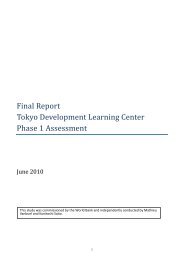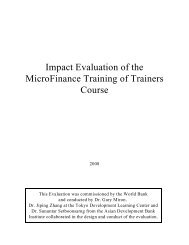The Joint Advocacy Network Initiative (JANI) Working together for ...
The Joint Advocacy Network Initiative (JANI) Working together for ...
The Joint Advocacy Network Initiative (JANI) Working together for ...
You also want an ePaper? Increase the reach of your titles
YUMPU automatically turns print PDFs into web optimized ePapers that Google loves.
<strong>The</strong> <strong>Joint</strong> <strong>Advocacy</strong> <strong>Network</strong> <strong>Initiative</strong> (<strong>JANI</strong>)<br />
<strong>Working</strong> <strong>together</strong> <strong>for</strong> safer communities<br />
against disasters<br />
Funded by: European Commission<br />
Humanitarian Aid Office
LAO CAI<br />
CHINA<br />
YEN BAI<br />
PHU THO<br />
BAC GIANG<br />
CBDRM<br />
Project<br />
locations<br />
LAOS<br />
THAILAND<br />
THANH HOA<br />
NGHE AN<br />
HA TINH<br />
QUANG TRI<br />
HUE<br />
KON<br />
TUM<br />
BINH DINH<br />
CAMBODIA<br />
DAC NONG<br />
NINH THUAN<br />
DONG THAP<br />
AN GIANG<br />
TIEN GIANG<br />
BEN TRE<br />
BINH THUAN
Background of CBDRM approach in Vietnam<br />
Why?<br />
- In line with Government’s policy on 4 on the spot<br />
policy and grassroot democracy policy<br />
- <strong>The</strong>re is the gap between village and commune<br />
level. CBDRM fills up the gap and contributes to<br />
reducing risks.<br />
- More chances to participate, express people’s ideas,<br />
needs.<br />
-
When first applied in Vietnam?<br />
- Started with participation of people in 1990s.<br />
- World Vision’s CBDRM project in central Vietnam<br />
- CECI’s 1998 project in central Vietnam<br />
- Red Cross’s 1998 CBDP project nationwide<br />
When CBDRM becomes a buzz word in Vietnam?<br />
- After the adoption of Hyogoframework in Vietnam<br />
- Since last few years.
CBDRM framework - specific models applied by<br />
<strong>JANI</strong> members<br />
Common concept and principles:<br />
- Participation, particularly vulnerable groups<br />
- Ownership of / decision making of local people<br />
- Integration, looking at vulnerabilities from other<br />
sectors (livelihood, education, climate change,<br />
health, etc).<br />
- Mobilizing local resources, indigenous knowledge,<br />
expertise.
CBDRM framework - specific models applied by<br />
<strong>JANI</strong> members<br />
Model/process:<br />
- Capacity building/trainings<br />
- Participatory vulnerability, capacity assessment by<br />
communities<br />
- Making safer commune plans<br />
- Implement safer commune plans<br />
- Awareness raising
Achievements<br />
<br />
Government is becoming interested in this<br />
approach. <strong>The</strong> proof is the development of CBDRM<br />
nationwide in 10,000 communes. <strong>The</strong> second proof<br />
is the adoption of National strategy in which it also<br />
commits resources to this approach. This indicates<br />
a major shift in policy making in terms of disaster<br />
risk reduction.
Achievements<br />
<br />
<br />
Multi-hazard approach in CBDRM through last<br />
workshop on developing a disaster management<br />
legislation.<br />
Initiated a shift in Media from response/recovery to<br />
preparedness
Achievements<br />
<br />
<br />
<br />
<br />
Typhoon resistant house models in central region<br />
(low cost, sustainable, replicable).<br />
<strong>Working</strong> with ethnic groups in the North (using<br />
indigenous knowledge)<br />
Mangrove planting in salt water areas (linking<br />
livelihood and DRR)<br />
Child-focus model in the Mekong (saving lives)
Achievements<br />
<br />
<br />
<br />
Mainstreaming DRR lessons into school program<br />
Vulnerability assessment (taking a comprehensive<br />
approach to risks)<br />
Improved rescue capacities <strong>for</strong> communes<br />
(training, equipment, planning)
Lessons learnt and experiences<br />
- Awareness of CBDRM approach at Central<br />
Government is high, but can be improved at lower<br />
levels<br />
- Different understanding of CBDRM approach, thus<br />
different ways/things of CBDRM, thus difficulties in<br />
producing a common CBDRM advocacy campaign
Lessons learnt and experiences<br />
- Challenge is now to trans<strong>for</strong>m policies and<br />
commitments into concrete actions at local levels<br />
(capacities, understanding, resources are not there<br />
yet).<br />
- You need legal framework, commitment, a shift in<br />
mindset to integrate safer commune plans into<br />
overall socio-economic plans
Recommendations<br />
- Establish a common understanding of CBDRM<br />
among NGOs be<strong>for</strong>e advocating <strong>for</strong> it.<br />
- Documentation and sharing of CBDRM framework,<br />
good practices within Vietnam and Region.<br />
- Need a capacity building <strong>for</strong> local levels
Recommendations<br />
- Enough resource allocation to CBDRM activities<br />
- Policies should cover not only water born disasters,<br />
but other disasters.<br />
- Integration of climate change adaptations into safer<br />
commune plan.

















